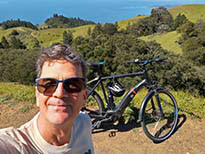* * *
A pair of coyotes greeted us as we parked at the end of Bon Tempe Road. Unfortunately, although I got my point-n-shoot camera out in time to fire off a few frames, my camera was still set in manual exposure mode for a photo of the moon rising after sunset. Not even close for coyotes in daylight. I didn't realize the mistake until I was trying to get a shot of this Great Egret on top of an oak tree, with the East Peak fire look-out in the background.
There'd been frost in all the shaded areas on the way in, but the sun was bright and warm when we set out around 8:15 a.m. to cross Bon Tempe Dam. Once we reached the other side to hike out around the south side of Alpine Lake, it would be quite a while before we'd feel the sun's warmth again.
Rocky Ridge Road goes up to the left. We went right to pick up the Kent Trail.
There were lots of ducks, coots and mergansers at this side of the reservoir, but we were surprised to spot three river otters. Judging by all the crunching sounds, they were finding plenty to eat.
The pump sits out in what I would guess is the deepest part of the reservoir. It sure seemed low, but the water district's total capacity (from all seven reservoirs) is only a little below average. It was interesting to note that per capita water consumption this year is much higher than in 2012. I guess when there's less water falling from the sky, people draw more from storage.
It's a beautiful hike out along the edge of Alpine Lake, now through meadow, then forest, then chaparral, and back into forest.
This was our first sunny spot since Bon Tempe Dam. I didn't take a picture of the junction of the Kent Trail and the Helen Markt Trail (which we'd already passed by this point), but it is well-signed and easy to see.
This is one of the biggest Douglas fir trees I've seen out here, and it has a crazy secondary trunk that's as big as a regular tree in its own right.
Once you leave the lake, it's pretty much all uphill on the Kent Trail.
This Doug fir was running with sap, not looking long for the world.
On the maps, this spot is named Foul Pool. They might as well have named it Dragon Swamp. It's no more "foul" than it is the lair of dragons. I'd never been here in the dry season before. Often the edge of the pool comes close to the trail, but it's receded so far at this point that there's nothing but deer-tracked mud quite a ways in. Deer have been browsing on the cattail leaves.
The trail ascends into a nice little redwood grove.
Not all the redwoods are "little", like this fire-hollowed champ with multiple shoots.
No, this is not a picture of Pam petting a triffid. I guess it's got to be a young Hericium erinaceus, or lion's mane fungus. It would be great to see this again in a couple of weeks since it will likely have become much bigger, its spines much longer. This was growing on top of a huge, downed bay laurel log.
Numerous honey mushrooms were also growing on the log and on other decaying wood nearby.
We left the Kent Trail, which heads up toward High Marsh, to join the Stocking Trail (named for Clayton Stocking, a long-time MMWD employee. (Link to info on other Mt. Tam place names here.)
This is Hidden Lake along the Stocking Trail. This will be a very different scene once the rains get going again.
I'd never hiked the Stocking Trail past Hidden Lake before, so it was interesting to see completely new territory, including the biggest redwood I've seen anywhere on the mountain outside of Muir Woods.
The woods were great, but it was nice to emerge into the sunny chaparral to continue our climb.
The Stocking Trail meets up with the Rocky Ridge Trail. For a shorter loop, you could simply turn left here and end up back down at Bon Tempe Dam.
We took a right turn instead and continued our ascent.
Rocky Ridge meets up with the Lagunitas-Rock Spring fire road which goes all the way down to Lake Lagunitas. That's Bon Tempe lake (and a toyon chockablock with red berries) behind me.
Pam adjusts her shoes where we leave the fire road for the Berry Trail down to Bon Tempe Lake.
Lovin' life on the Shadyside Trail.
Almost back to the dam, we enjoyed a short break at a nice open spot on the edge of the lake. Hiking at a leisurely pace, the 6.6-mile loop took us just under four hours.
* * *




































































